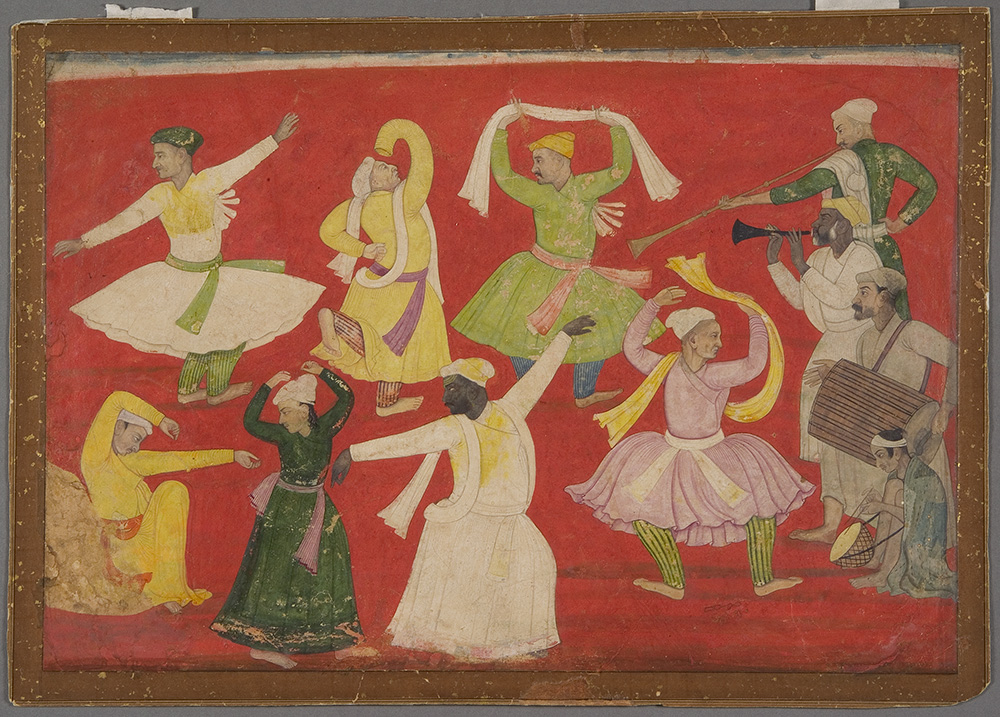
Attributed to Pandit Seu (Indian, 1680–1740), Dancing Villagers, circa 1730, India, Himachal Pradesh, Guler, opaque watercolors on paper, Los Angeles County Museum of Art, from the Nasli and Alice Heeramaneck Collection, Museum Associates Purchase, M.77.19.24, page: 22.2 x 29.2 cm; painting: 18.4 x 26 cm
Verbal Description
Hello, my name is Julie Desai. I am a community partner of the Cincinnati Art Museum. I will be reading the verbal description for Dancing Villagers in Beyond Bollywood: 2000 Years of Dance in Art.
Attributed to Pandit Seu, an Indian artist who lived from 1680 to 1740, the painting Dancing Villagers, dates to circa 1730. It is from India, specifically the state of Himachal Pradesh, Guler. It is opaque watercolors on paper. It is in the collection of the Los Angeles County Museum of Art, from the Nasli and Alice Heeramaneck Collection and Museum Associates Purchase. The accession number is M.77.19.24.
Dancing Villagers is a landscape oriented opaque watercolor painting on paper. It measures 18.4 by 26 centimeters on a 22.2 by 29.2 page. A group of seven dancers is randomly distributed across the image and painted on a muted red backdrop. Along the right side of the image are four musicians, two standing playing long-necked horns, and two others playing drums. One of these drummers is seated in the foreground. The group of dancers all appear to be male. They wear long sleeved, belted and skirted tunics over pants in colors of yellow, white, light purple, light and dark green. They all appear to be wearing turban-like head coverings. The figures all face in different directions and have unique gestures associated with their dance. Two of the dancers hold scarves aloft over their heads.
Label Text
Hello, my name is Julie Desai. I am a community partner of the Cincinnati Art Museum. I will be reading the label for Dancing Villagers in Beyond Bollywood: 2000 Years of Dance in Art.
Attributed to Pandit Seu, an Indian artist who lived from 1680 to 1740, the painting Dancing Villagers, dates to circa 1730. It is from India, specifically the state of Himachal Pradesh, Guler. It is opaque watercolors on paper. It is in the collection of the Los Angeles County Museum of Art, from the Nasli and Alice Heeramaneck Collection and Museum Associates Purchase. The accession number is M.77.19.24.
Seven men dance with abandon to the tune of four musicians. Arms extended and knees bent, these animated figures are positioned against a red background, with only a hint of the ground below and the horizon line above. Unusual for a painting from the later Indian courts that portrays dance, the figures are devoid of a larger court, performance, or narrative context. Instead, an intensity is created and communicated through each expressive face and writhing form. This is dance without a discernable organized presentation or recognizable postures.
This painting has previously been published as “Dancing Dervishes,” yet neither title captures its essence—of dancers unabashedly absorbed in movement. The identification as dervishes and a dance linked to Sufi devotional practices likely comes from the elongated sleeve of one dancer. In earlier Persian and then Mughal painting, elongated sleeves symbolized contemplation, transcendence, and intoxication in both physical and spiritual realms.
